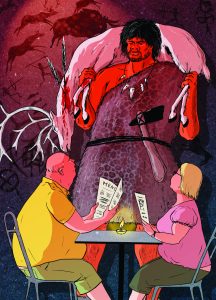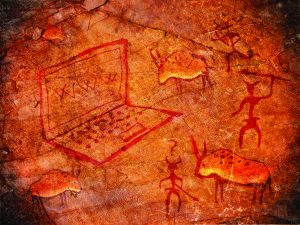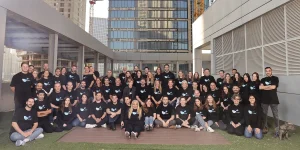We love to yearn. Longings, especially those reserved for distant periods, allow us to grumble quietly about our lives. They say it was much better on earth before we were born? Apparently, we miss the earlier periods immensely. We miss the Paleolithic period, for example. When everything was simple, natural and healthy, down to earth. At least that’s what the proponents of natural selection tell us. Whole doctrines sell us this idealization of earlier times, trying to emulate them and claiming that long ago, it was simply better here on Earth.
The popular Paleolithic diet, which attracted to it masses of people all over the world, calls on its followers to go back to living on the diet of the ancient man, in order to avoid the diseases of the modern age. Or, in other words, to eat mostly meat and saturated fat, which stands in stark contrast to any familiar conception of a healthy diet. The advocates of the trend of natural medicine passionately call for a halt to immunization of children, and oppose most conventional drugs.
You may even ask, how authentic is it to yearn for and miss the primordial period, with civilization enveloping us from all sides, electricity and water flowing freely and our smartphones constantly fully charged? So the real question is, is there truth behind this nostalgic yearning? Did the ancient man really live a healthier life, and to what extent is today’s human evolution adapted to the diet and lifestyle of that period?
“The attempt to return to the Paleolithic period – from 2.5 million back and continuing on to 10,000 years back – was based on the idea of a person who lived in perfect harmony with the environment, and his diet consisted only of healthy foods that could be found in nature,” says Vered Shapira, biologist at the Davidson Institute for Science Education, the educational section of the Weizmann Institute of Science. “That way, this same person doesn’t need or harm the environment, he’s very healthy and strong and not subject to stress. However, this is complete nonsense. The Paleolithic diet relies on food that is not domesticated and processed, on food consumption that exists only in the natural environments, but there is no connection between the foods that existed more than 10,000 years ago compared to what exists in our supermarkets today. Back then, the tomatoes were small and shriveled, nothing like the tomatoes we have today. Cabbage – cauliflower and broccoli didn’t even exist – was less developed, and of course, the meat today is different than it was – the beef back then is not the same beef we consume today. The diet in prehistoric times was based mainly on carcasses, some on hunting and fishing and on seeds the women collected. All of that is not suitable for the supply we have today.”
Every Strawberry A Different Taste
Guy Bar-Oz, Professor of Archeology at the University of Haifa, agrees. “The amount of saturated fat that existed in animals back in ancient times was very small compared to what exists today in a cow. And I’m not even mentioning the fact that during the Paleolithic period, men would hunt animals that today are protected and therefore forbidden to be hunted, like deer, for instance.”
Not only is the meat different, the fruits and vegetables we eat today are also new evolutionary strains, and are of course sprayed with pesticides and other unnatural substances. “They do not even resemble the fruits and vegetables that could once be found in the Paleolithic period in the forest, when each strawberry had a different taste based on the soil in which it was grown,” explains Professor Bar Oz. “If you look at the composition of the plant foods that were eaten during the Paleolithic period and were discovered in excavations dating back to 25,000 years ago, you can finds dozens of fruits and plants, and we have no chance of reaching such a vast variety today.
Beyond the fact that the Paleolithic diet does not exist today in the same format it existed back then, it also doesn’t fit the way of life in the modern world where natural resources are consistently being used in immense portions and the physical space left on the Earth is shrinking. “If our diet is based solely on meat, the environment will not be able to produce food for us in the end,” explains Professor Bar-Oz.
One of the main claims of the proponents of Paleolithic nutrition is that the human genome has changed very little since the appearance of Homo sapiens, the modern man, some 40,000 years ago. 99% of our genes, according to the Paleolithic theory, originated from prehistoric times, when developments, such as the industrial revolution, commercial agriculture, and the modern processing of food, did not affect our genes at all. So, if we are almost genetically identical to the primordial man, we only need to trace his diet to better health.
“They say our bodies are adapted to eating everything that our ancestors ate, and since we developed the industry very quickly, we now give our body food that it does not know how to deal with. However, that is not true,” says Shapira. “Our evolution is much faster than they used to think, and the most obvious example is that in the past, humans could not bread down milk beyond infancy, and today, most of us are able to break down lactose. This is because people started to consume milk at a young age. Evolution of the blue eyes is also a relatively new matter, created some 6,000 years ago, so it is absolutely not true that our evolution is developing slowly.”
Shapira adds that billions of intestinal bacteria are responsible for the breakdown of food in our bodies, and these bacteria are very different from those of our forefathers. “You could not say that the intestinal bacteria we have today are better or worse than the bacteria the ancient man had back then, they are simply different. There is this thought that the primitive man lived an ideal life, but there is no such thing as an ideal life.”
They Ate and Paid the Price
In other words, life is a compromise. Those who want to live like our forefathers are only looking for a different kind of compromise. There is no perfect adaptation to our environment, and living in total harmony with nature is a fantasy. For example, if we take an animal living in nature, we find that it must run fast and find food, as well as maintain its warmth. The fact that animals are equipped with long limbs for running can make it difficult for them to cool their bodies during the hot seasons. It will always be a compromise: one feature will meet a particular need, but may harm another. “In the end, it’s ecology, and in the Paleolithic period, they ate what they had and paid a price,” says Shapira. “Although they did not eat sugar and processed foods, which certainly reduces the risk of diseases such as obesity, diabetes, hypertension, and other disease of the Western world, can we really say that the ancient man was healthier? He had common artery blockage because of the fat he ate and his teeth would wear out when eating uncooked seeds.”
When one talks about the lifestyle of our ancestors, we must remember that, generally, they didn’t live long. In the 19th century, life expectancy was about 40-50 years old. The big breakthrough came only in the beginning of the 20th century, especially with the discovery of penicillin – the same antibiotic drug that natural cure seekers are opposed to. If bacteria can be killed, why can’t we live beyond the 100-year mark? From there, the road to a futuristic world that speaks of a lifespan of 150 years – with Nano technological developments such as artificial intelligence, genetic engineering, and 3D tissue printing for organ exchange – was very brief.
“Although the lifespan of the ancient man was about 35 to 40 years old, we know that there were also those who managed to live longer than that. Yet in any case, the reason for a longer life was not because of nutrition,” says Shapira. “If anything, there is evidence that the Paleolithic man died of heart disease following the diet. It is extremely unhealthy to cook animal fat, as was done in the Paleolithic diet. The main causes of death at an early age were infectious diseases because there were no antibiotics and no vaccines. If the Paleolithic man didn’t encounter a lion or a virus, he was able to live longer.”
Maybe this is what lies behind the theory of returning to the lifestyle of the ancient man: even the simplest virus could have killed the primordial man, but his chance to run into it was much lower than it is today. “Hunters lived in low density and were constantly on the move, so it was nearly impossible for the bacteria to be able to live and stay with them,” says Bar-Oz. “All of the infectious diseases of the modern age stem from the density of the population, and the solutions we found for this are, among other things, sewage channels that block exposure to pathogens and vaccines.”
The Thing About Vaccinations
Try telling that to the parents who strongly oppose vaccinating their children. Although the percentage of vaccinators in Israel is considered high, standing at about 96%, a recent survey by the Israel Medical Association found that 10% of parents do not fully vaccinate their children, while 1% chooses not to vaccinate them at all. In recent years, more educated parents of higher socioeconomic status have chosen not to vaccinate, mainly due to the fear of side effects.
“Vaccination is a wonderful thing,” says Shapira. “Before the age of vaccination, some children did not survive beyond the age of one year because of diseases that today seem foolish, like the chicken pox. Parents that choose not to vaccinate their children today feel like heroes, but their children are protected only because of the overwhelming majority of children that are vaccinated. If not vaccinating children becomes a trend, those children will infect other children, and we’ll start seeing diseases we thought had disappeared from the world.”
An example of a disease like this is Pertussis, otherwise known as whooping cough. In the 1940s, the vaccine for the disease appeared, along with the decline in morbidity rates. “Opponents of vaccines rely on fears of serious side effects of fear of hazardous substances. However, science refuses to accept the argument that vaccines cause these problems. The link between autism and vaccines is completely and utterly refutable. Of course there are failures in modern medicine, and science is not always accurate, but still, it is impossible to compare the stability that exists today to the diseases that existed in the Paleolithic period or to the days before the invention of penicillin,” says Shapira. “Secondly, in the distant past, vaccinations had in them mercury that was considered dangerous. The amount of mercury in the vaccinations was minimal, less than the amount of mercury found in a tuna sandwich today. Also, it was never proven that there was any association between mercury presence and vaccine-related side effects, but regardless, it has been years since vaccines were made up of any bit of mercury. People may react to vaccinations differently, but that is no reason to throw medicine and science away or to choose not to vaccinate an entire population and to instead return to the life of the ancient man. On the contrary, this will mainly be a return to high mortality rates in infancy.”
Trends of Faith

Still, it seems difficult to convince the convinced. Opponents of vaccines hold discussions on the subject in designated forums on the Internet and on various Facebook pages. The Paleolithic dieters have dedicated Facebook pages and groups to the trend, with thousands of members believing that this diet is the best of the best. Or maybe this is the key to the nostalgic romanticizing of the past, a past none of us really know? Is it the simple and basic need to belong, to be part of a group?
“We all have a natural tendency and nostalgia for the past, for other days. We are all looking for an anchor to connect to so that the togetherness will exists unconditionally,” explains Dr. Moti Gigi, sociologist at the Sapir Academic College of Communications. “The yearning for the Paleolithic period reflects a yearning for nature, for Mother Earth and for natural food. It is important to understand that the context is the postmodern period we live in today, with all the endless abundance and progress, leading to a sense of futility.” And lack of purpose leads to constant search. “The problem is that we lost the ability to be happy with the simple things,” Dr. Gigi continued. “Once, we thought that if we studied at a university, we would graduate with a degree, get a job, and be happy. However, we now see that this is not always the case. On the contrary – having more won’t necessarily make us happier.”
For this reason, more and more groups of people are emerging, clustering around new and shared beliefs. “I call it trends of faith,” says Dr. Gigi. “Veganism, for example, is a concept of religion, which also reflects a return to nature. The trend of fair trade, which is the privilege of the upper-middle class, reflects a belief that unites this class and helps them feel comfortable with their status. We are holding on to nostalgia, because in today’s society there is almost no solidarity, and we have to hold onto something. For the most part, what we hold on to will be memory. The beauty in memory is that it neutralizes the bad and perceived only the good.”
Dr. Gigi argues that there is no scientific evidence that the way of life in ancient times was really better. “Despite all of the modern industrial influences, in terms of life expectancy, we live longer today than we ever have before,” he says. “Studies show that modern man can not survive in most cases, because he doesn’t know how to light a fire from natural resources or how to create circuitry. The way of life today may be problematic, but that definitely doesn’t mean that we’ll be happier if we return to the way the ancient man once lived.
Translated by Raz Tal







